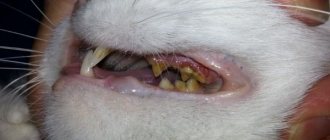Treating scratches at home
Most often, the owner decides to observe the development of events; in the end, the cat may itch due to nervousness. If the cause is not determined correctly, the situation worsens and scratching becomes painful. The progression of the disease can be determined by the reaction of the animal, which does not allow the scratches to be examined or simply hides.
There is another scenario for the development of events - the external scratching is delayed, and the infection that has “settled” on open wounds goes into the deeper layers of the skin. This happens for two reasons - complete ignorance of the problem or treatment of the animal’s skin at random.
Simply put, when you see a scratch or scratch, you should not smear it with all the ointments that can help; it is better to adhere to the standard treatment regimen or consult a doctor. If abscesses and boils form, you need to consult a doctor, since for recovery you need to remove the infection from the deep layers of the skin as quickly as possible. If the veterinarian doubts that the cat's immune system is functioning at full strength, non-steroidal anti-inflammatory drugs may be prescribed.
Note! Scratching is called a hot spot because the body temperature in the affected areas is usually higher than the base temperature.
If the inflammation does not seem extensive or painful, treatment at home comes down to preventive measures. If you do not allow infection to occur, and the cause of scratching does not lie in illness, the wounds will heal within a few days.
To disinfect and relieve discomfort, wounds are wiped with non-alcohol tincture of calendula. It is best to buy a collection of herbs and make a decoction yourself. If you need to act quickly, and only an alcohol solution is on hand, you need to fill it with hot water or boiling water so that the alcohol evaporates as quickly as possible.
Local discomfort is successfully relieved with cool lotions. For cooling, you can use herbal decoctions - oak bark, calendula, chamomile , etc. You need to be careful with lotions because wounds need to dry out to heal. By the same logic, scratches should not be bandaged or sealed. If the cat actively licks wounds, use an Elizabethan collar or follow the regimen prescribed by the veterinarian.
Note! If a cat has scratches on its head, the use of a collar is mandatory and the main danger is not infection of the wounds, but in causing a traumatic brain injury during scratching with its paws.
If you want to rid your cat of scratching, you need to heal not the wounds, but the reasons for their appearance. The word comb comes from “to itch”, which means that the cat is bothered by itching. You need to understand that when the skin just itches, the animal does not tear the skin to the point of wounds.
Treating scratches at home
If a cat scratches itself until it bleeds, the first step is to treat the wound so that it does not get infected. Regular human ointments are suitable for this.
To avoid further scratching of the skin, the cat should trim its claws and cover the problem area with something (for example, put a special collar or vest on the animal).
If a doctor has diagnosed lichen, the sick animal must be isolated from healthy ones. The fur next to the affected area is shaved off. The affected area is treated with ointments.
If an animal is taking any anti-inflammatory or immunosuppressive drugs, they should be stopped for a while so that the body has the strength to cope with the fungus.
The room in which the cat lives, as well as all objects with which it comes into contact, must be disinfected. Treatment of lichen can take quite a long time, but if its initial stages are detected, the animal will fully recover.
A special diet will help overcome food allergies. A product that causes a negative reaction should be excluded from the diet. You can also purchase commercial food for cats prone to allergies.
Atopic dermatitis can also cause itching. This is also an allergic reaction of the cat’s body, but it is impossible to isolate the exact allergen and completely eliminate it. Atopic dermatitis cannot be cured, but with the help of medications, all negative manifestations of allergies can be eliminated.
If a cat is suffering from a bacterial infection, the first step is to use various ointments. If an animal develops ulcers, the doctor will prescribe a course of antibiotics.
If the disease becomes chronic, the veterinarian takes microbiological tests. This is necessary to prescribe the most effective treatment for this type of bacteria.
When do you need veterinary help?
Often, scratching is almost harmless and does not cause the animal much discomfort. The owner may not even immediately notice that something is wrong with the pet. Problems begin when bacteria get into the wound. In this case, an abscess may form on the skin. In some cases, without timely treatment, the area of scratching may increase.
You might be interested in: Should I be concerned if my cat is constantly licking itself?
If an animal scratches a small wound once, there is no need to sound the alarm. Perhaps the cat just overdid it. The wound should be treated and the pet should be monitored.
In what cases should you take your pet to the veterinarian:
- The cat scratches the same place for a long time until it bleeds.
- The area of scratching increases.
- The wound oozes pus or does not heal.
- Scabs form on the affected area of the skin.
- The cat's hair falls out and bald patches form.
- The animal is constantly itching.
Scratching is often one of the symptoms indicating that the animal is unhealthy. In this case, you should pay attention to the general condition of the cat. You should contact your veterinarian if the following symptoms accompany itching:
- Decreased activity or excessive agitation.
- Increased body temperature.
- Lack of appetite.
- Nausea, vomiting, diarrhea.
Diagnosis of scratching and itching
Itching is probably one of the most unpleasant sensations that can only be relieved by scratching. It has been proven that a person can become psychotic if they experience itching and cannot scratch themselves. Itching in an animal is a clear sign of skin damage, although it can occur before obvious symptoms appear. In veterinary medicine, as in human medicine, itching is distinguished depending on its nature:
- Localized – one or more specific places are itchy, for example, scratching appears only on the face or on the neck and cheeks.
- Generalized – when the cat’s entire body itches.
If you notice that your cat is scratching hard, you need to consult a doctor, because even in a veterinary clinic, it is very difficult to establish the correct diagnosis. Typically, the doctor suggests conducting an examination by scraping the skin, treating the cat’s scratching and observing the dynamics.
Laboratory analysis of scrapings should reveal the causative agent of the disease, but this does not always happen, since the causes of itching are not always “on the skin”. For example, stress can lead to a generalized type of itching, the cause of which cannot be detected by any analysis.
Note! When visiting a doctor, you should collect at least a minimal analysis, because if, in your opinion, the cat is itching a lot, the doctor must be sure that this behavior is not related to hygiene.
For example, during shedding, cats itch more and lick themselves more intensely in order to improve blood circulation in the skin and get themselves in order.
It’s a little strange, but in fact, many owners turn to the veterinarian because the animal has scratching, bald spots, wounds, but without itching. That is, the owner did not notice that the cat was scratching more than usual and believes that the scratching occurred on its own. Sometimes, the owner notes that the four-legged dog did not itch more than usual, but washed itself very intensively and had bald spots - this is the result of licking.
Hypothetically, this situation is possible, but in practice, it is most often associated with itching. An experienced veterinarian can easily distinguish between a scratch and a licked wound, that is, he will determine that the cause of the problem is itching. In the case of licked wounds, a completely different diagnosis is carried out , since the causes of their occurrence are not so varied and obvious.
Main reasons
There may be several reasons why a cat scratches its skin until it bleeds. The most common of them are the following:
- Helminthiasis.
- Inflammation of the skin of a bacterial nature.
- Ringworm.
- Parasites.
- Manifestations of allergies.
- Hormonal abnormalities.
Helminths
The development of helminths in a cat’s body is accompanied by the following symptoms:
- Itching in the anal area;
- Disruption of the digestive system;
- Change in the appearance of fur;
- Inflammation of the eyes, appearance of discharge;
- Changes in behavior, manifestations of lethargy and apathy;
Worm infestation is extremely dangerous for cats. They devour tissue, lymph, and deplete the body. The substances they release cause severe intoxication. When certain symptoms appear, the cat itches a lot, sometimes bloody wounds appear at the site of scratching. An infection gets there, and the animal’s condition rapidly deteriorates.
To protect your pet from helminths, you need to pay special attention to hygiene. It would be a good idea to limit your cat's diet by excluding raw foods. The tray must be cleaned immediately.
Skin inflammation
With bacterial inflammation, scratching the skin leads to the fact that the coat is filled with pus and bloody discharge. This is not a very pleasant sight for the owner. This condition is very painful for the cat.
The causes of bacterial dermatitis are:
- Inappropriate quality of animal nutrition;
- Liver pathologies;
- Disturbances in the gastrointestinal tract;
- Avitaminosis;
You might be interested in: Why does a cat shed a lot?
The symptoms are quite typical for dermatitis: the reddish lesion gradually expands, begins to get wet and secrete fluid. The fur falls out at the site of the lesion, and the animal develops a fever. The cat scratches its skin until it hurts. The consequences are the appearance of pus in the wound and refusal to eat.
Antibacterial drugs are used to treat animals. This is a rather delicate point, since bacteria and viruses have a certain resistance to drugs. It is necessary to select an effective remedy experimentally.
Ringworm
The appearance of lichen in a cat is easy for an attentive owner to notice. It is easy to understand that the appearance of spots on the skin, the shade of which changes to pale pink, is associated precisely with this disease. The skin becomes dry and peeling develops. The condition is extremely uncomfortable for the cat. Severe itching, the appearance of purulent ulcers, alopecia - all these are consequences of neglect of lichen.
The disease can occur anywhere on the body, but most often affects the area under the neck, ears, abdomen and top of the head. The animal shows indifference to games, refuses to eat, and scratches the affected areas vigorously. The coat becomes unkempt, dull and greasy.
To avoid such manifestations, you need to try not to let the animal go outside. Rodents caught there are often carriers of lichen. Treatment should be comprehensive, but it’s still not worth choosing the drug yourself. To determine the type of lichen, it is better to consult a veterinarian.
Fleas and other parasites
The moment parasites appear on a cat’s body may not be noticed. Small black specks can be fleas, scabies mites, nits, or lice eggs. As the disease develops, the parasites cause great discomfort to the animal, causing severe itching.
The animal is processed independently. The drugs are sold in veterinary pharmacies. The owner must show maximum patience and perseverance, and his efforts will be rewarded with the health and good mood of his pet.
Allergic reactions
Scratching the skin until it bleeds may result in allergic reactions. The animal may scratch its face, lick and bite its limbs.
You might be interested in: A cat was bitten by a wasp: how and how to help your pet?
Food allergies are more common. In this case, you should be especially careful when preparing a diet for your cat.
It would be useful to prescribe her a diet, excluding suspected foods. In some cases, you cannot do without antihistamines, which can be purchased at any pharmacy.
Hormonal imbalances
This physiological reason rarely causes a cat to scratch its skin until it bleeds. However, it is better to have an idea about it in order to help your pet when itching occurs. Hormonal imbalances occur due to thyroid dysfunction, diabetes mellitus and Cushing's syndrome. There is a change in the quality of the coat, severe itching, and in some cases the appearance of bald patches. It is necessary to treat a cat, first of all, for a physiological disease that provokes severe itching, but it is also necessary to relieve symptoms.
Causes of scratching
The first thing the doctor will do is examine the animal for the presence of parasites. Flea scratches appear all over the body, most often on the cheeks, neck, chin and at the base of the tail. In most cases, even if the animal has recently been treated, parasites are the cause of the itching.
The cat itches because the saliva of blood-sucking parasites always causes an allergic reaction. If you have ever been bitten by a flea or tick, you know that the bite itself is not felt, but afterwards it itches a lot. Flea saliva, injected under the skin, acts as a pain reliever, but since it has a protein base, after some time an allergic reaction occurs.
Note! The development of a flea allergy does not always imply the presence of a large number of parasites; for cats with sensitive skin, a few bites are enough for scratching to appear.
The next most popular reason is microscopic mites. Itching from mites is incomparably stronger than allergic; the area affected directly depends on the method of parasitism. For example, when infected with ear mites, a cat scratches the skin near the ear, forehead and back of the head within 24 hours. The subcutaneous mite can settle on the back, body, under the arms or even on the tail. To confirm or refute the diagnosis, a scraping is taken from the damaged skin for laboratory examination.
During laboratory analysis, scrapings are also checked for the presence of spores, which will indicate a fungal infection of the skin. Cats, dogs and people constantly have fungi and microorganisms living on their skin; not all of them are friendly, but the symbiosis is designed so that the bacteria do not attack the host. When the level of immune defense drops or an active, unfriendly culture is introduced, the cat may develop microsporia, which for many is more commonly called lichen.
Statistically, cats are more likely to get ringworm, but are practically not susceptible to other skin ailments. If the diagnosis is confirmed, the veterinarian will prescribe a course of treatment. Typically, treatment for ringworm involves injections or oral medications. Scratching should be smeared with antiseptic ointments with an antifungal effect.
Important! The symptoms of itching and allergic skin reactions are very similar (redness of the skin, itching, scratching), but are treated differently.
Allergies as a cause of itching and scratching
If all of the above reasons are excluded, the doctor will assume an allergy.
Food allergies
If you're lucky, the allergy will be food, that is, caused by eating foods or feed that are not entirely suitable for the cat. Food allergies are identified by taking a detailed history. It is important to remember what you fed your ward for the last 10 days, did you change the food, did you treat it from the table, etc. To alleviate the condition, the animal is transferred to a neutral diet and supported with antihistamines. How to recognize allergies in the video below:
Gradually, the cat’s diet begins to expand by one product at a time and the reaction is monitored. Many purebred cats are allergic even to different types of meat. Recently, allergies to store-bought chicken meat have become very common, apparently due to the solutions used to treat carcasses. Eliminating food allergies will take time; the quickest option is to switch the animal to high-quality hypoallergenic food.
Non-food allergies
Non-food allergies are much more troublesome, since the pet’s reaction can be associated with any object in the home. First of all, bowls and bedding are changed. By the way, if you recently washed your cat’s bed, the cause of the allergy may be in the detergent. The cat is not bathed with shampoos and is kept in as neutral an environment as possible. During all preparations, the animal is prescribed antihistamines.
Important! Determining the type of allergy a cat has through testing is not entirely relevant. When an animal is already scratching, the immune system is very stressed, which can give false positive results.
Non-food allergies can be seasonal, for example, during the flowering of grass, a cat may develop a reaction to spores and pollen, in dry weather - to dust , etc. In this case, the animal’s condition will be alleviated only with antihistamines. Sometimes, the reaction is partially controlled by diet, since it relieves the general stress of the immune system.
Important! Atopic dermatitis is another type of allergy whose causes cannot be determined. It is believed that atopy occurs against the background of a combination of causes - dust, spores, pollen and other microparticles concentrated in the home.
If the veterinarian is unable to identify the cause of the allergy, the animal is given gentle therapy, which is carried out in courses and helps combat itching. Not the best, but sometimes the only option to improve the quality of life of the ward. The cat's condition must be constantly monitored, since atopy occurs for unknown reasons and can also disappear suddenly.
Advice: if a prompt appointment with a veterinarian is not possible, you need to treat the cat’s scratching with Levomikol, and you can use children’s Diazolin or Suprastin to relieve itching.
Causes of itching
Owners do not always immediately begin to sound the alarm when they discover scratching on their pet. Often they believe that this is not a very serious problem. If the scratching is minor and the itching does not particularly bother the cat, the owner can completely ignore this problem. But it is worth remembering that many diseases are curable only in the first stages. Therefore, it is important to promptly find out the cause of itching and provide professional help to your pet.
Lichen
This is an extremely contagious fungal disease that is also dangerous for humans. It is easily transmitted from a sick animal to a healthy one through short bodily contact, or even through grooming items (combs, nail clippers). Without timely treatment, lichen in dogs, like in cats, can lead to serious consequences for the health of the animal.
You might be interested in: Why does a cat have a constantly wet chin?
The main symptoms of lichen infection:
- The coat appears unhealthy. A large number of broken hairs.
- Small bald spots appear, which the cat actively scratches. They can be found primarily on the head, neck and paws.
- Hard crusts appear on bald spots.
- Lost fur grows back very slowly.
- Dandruff appears on the skin.
- In the final stages, purulent lesions form.
Skin parasites
Fleas are a very common parasite, especially among cats that have free access to the outdoors. Fleas are quite dangerous, because their bites lead to a decrease in the animal’s immunity. The cat becomes vulnerable to various bacteria and fungi. Flea bites cause severe itching, causing the animal to constantly scratch. Particularly sensitive cats may scratch their skin until it bleeds.
Your cat can also pick up ticks, lice and coccidia. However, the animal does not have to go outside for this. The owner may well bring some parasites with him on shoes and clothes.
The main symptoms of infection with skin parasites:
- deterioration in the appearance of fur;
- severe itching;
- anxiety;
- fleas and ticks can be seen visually if you look closely at the animal’s skin.
A tick bite can lead to quite serious consequences. At the same time, the animal’s temperature may rise, loss of appetite, and decreased activity.
It is best to consult a veterinarian to remove a tick. If the procedure is performed incorrectly, parts of the tick may remain in the animal's skin, which can cause a purulent abscess to form.
Allergy
An allergic reaction can occur completely unexpectedly in any cat. Most often, animals suffer from food allergies. It often manifests itself when changing the diet or adding new foods to it. Food allergies are the easiest to identify and therefore easy to combat.
But when diagnosing non-food allergies, problems can arise. In this case, it is not always possible to determine which allergen caused the body’s negative reaction.
An allergic reaction can be caused by:
- individual food products (often chicken and milk);
- pollen and plant parts;
- flea and tick bites;
- various chemical elements contained in cleaning products and perfumes;
- dust.
Otitis
Otitis of the external ear is a serious disease that can cause many problems for the animal. Infection of the ear canals leads to inflammation. The cat constantly shakes its head and scratches its face until it bleeds.
The main symptoms of otitis in a cat:
- redness of the ear;
- anxiety;
- the cat constantly shakes its head;
- the animal scratches its ears and muzzle;
- increased body temperature;
- In the absence of timely treatment, pus may begin to leak from the auricle.
Worms
Even completely domestic cats are not immune from infection with worms. Parasite eggs can enter the animal's body through raw meat, unwashed hands, clothing, and grass. Infection with helminths leads to decreased immunity and disruption of the body.
The main symptoms of helminth infection:
- Deterioration in the appearance of the coat, scratching.
- Defecation disorder.
- The animal quickly loses weight.
- Itching in the area of the anus, which causes the animal to rub it on the floor and carpets.
- Decline in activity or, conversely, excessive anxiety.
- In advanced cases, severe shortness of breath occurs.
Bacterial diseases
Bacteria and fungi are found in small quantities on the skin of any cat. Usually, they do not cause any problems to the animal. But if the animal gets sick, its immunity is reduced, and the body is weakened, fungi and bacteria begin to actively multiply, which often leads to severe itching and scratching.
You may be interested in: Why does the cat's eye become cloudy: causes, treatment methods
At risk are cats that already suffer from diabetes, allergies, and hyperthyroidism. This problem often occurs in kittens.
One of the most common bacterial infections in cats is pyoderma . Its main symptoms:
- severe itching;
- peeling of the skin;
- Scabs form on the wounds;
- baldness of certain areas of the skin;
- formation of purulent abscesses.
Pyoderma is very dangerous for cats. When the first symptoms appear, you should immediately consult a doctor.
Stress
All animals experience stressful situations differently. For some, moving or even ordinary fear can lead to not entirely adequate reactions. Constant licking of the same places may indicate mental disorders of the animal.
Of course, such a diagnosis can only be made after all other possible causes of itching have been excluded during the diagnostic process. The main symptoms of mental disorders and stress:
- refusal to eat;
- a decrease in activity or, conversely, excessive excitability;
- the animal constantly scratches or licks one place.
Breeds in which this problem most often occurs: Burmese, Orientals, Abyssinian and Siamese cats.
Disruption of hormone production
Disruption of the endocrine system leads to the appearance of various symptoms, including itching and scratching. A number of diseases that cause disruption of hormone production:
- Diabetes.
- Cushing's syndrome.
- Thyroid dysfunction.
Main symptoms:
- Hair loss and bald patches.
- Dryness and flaking of the skin.
- Severe itching and scratching.
Stress and mental disorders
It is rare, but it happens that scratching in cats is associated with a mental disorder. Most often, the wounds resemble scratches, but are not them, since the cat is actively licking itself. Wounds form on the paws and shoulder blades. The size and depth of the wounds is rapidly growing, but despite the pain. the cat continues to lick itself.
Assumptions about neurosis are relevant if all of the above reasons could not be confirmed. The diagnosis is confirmed by prescribing a course of sedatives, if the cat begins to actively lick itself and the wounds begin to dry out - the reason is stress.











